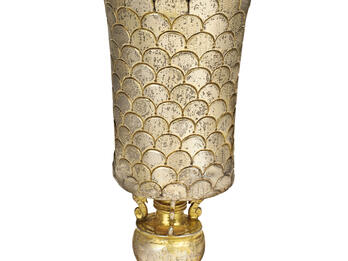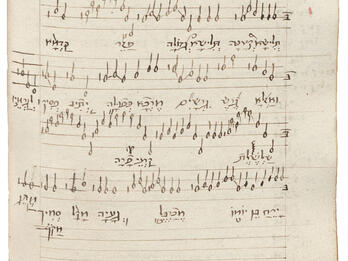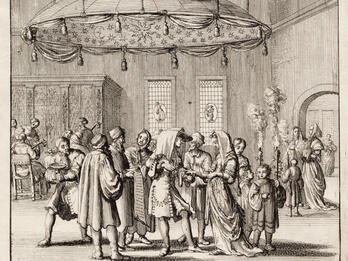Ner mitsvah (Light of the Commandment): On Hanukkah
And this, too, must be said, that the main reason for establishing the days of Hanukkah is because they [the Jews] were victorious over the Greeks. However, it did not appear that the victory was achieved through miraculous means from God; rather, it appeared through their own might and heroism. Therefore, a miracle was wrought with the lamps of the menorah, so that everybody would know that the result was a miracle from the Lord, and that the Jews’ triumph in the war was also thanks to God. And this miracle in particular was chosen, for the main evil of the Greeks was that they contaminated the Temple, as the sages refer to the stones of the altar that the men of Greece defiled [b. Avodah Zarah 52b], in several places. God saw their evil, that they defiled His Temple, and they also issued decrees of persecution, to nullify the Torah and its commandments, and therefore He empowered the Hasmoneans, who were priests, servants of God in His Temple, and they were the ones who were victorious, no one else. When they defeated the Greeks, they purified the Temple. And as they had no oil, a miracle was wrought for them, so they could purify and dedicate the House. That is why it is called Hanukkah [dedication], because they dedicated the Temple, after the men of Greece had defiled it. And it is for this reason that the miracle was achieved with oil, as the victory that the Jews won over the Greeks was because they had defiled the Temple, and the Lord wanted the service of the Jews, and therefore the miracle was performed with the lamps.
The Greeks defiled the Temple, as the Greeks had the special power to overcome the Temple more than the other nations. A sign of this is that the word for Temple [in Hebrew] has the numerical value of sixty-five, while the [Hebrew] word for Greece has a numerical value of sixty-six, which indicates that the kingdom of Greece has the power to overcome and defile the Temple. However, it is only from the aspect of the sanctuary [i.e., not the Holy of Holies] that Greece has the power to overcome the Temple. Consequently, when they conquered the sanctuary, they defiled all the oils that were there. It was oil in particular that they defiled, because oil has special sanctity. The proof of this is that all consecrated vessels are sanctified and anointed with oil (Exodus 30:26–33), and this is the main point of sanctity. Here too, Greece ruled, and they defiled all the oils.
Thus, there remained only one small vial, which contained the seal of the High Priest [b. Shabbat 21b], because the High Priest has additional sanctity, as he enters into the inner sanctum, the Holy of Holies, and this is an additional sanctity, and from this aspect the Greeks had no power over the Temple. Due to this special level of holiness, which is the Holy of Holies, the Greeks had no control over that little vial, which had the seal of the High Priest and was hidden away. For the letter heh of the [Hebrew] word for “Temple,” hekhal, is vocalized with the vowel tsere, and the letter yod effectively disappears, as it is heard in the reading of the tsere. This represents the lofty, hidden level in the Temple, which is the level of the Holy of Holies. The Greeks did not prevail over this, as the yod, which is silent and disappears, indicates that the Holy of Holies is hidden within the sanctuary, and they did not rule over the concealed Holy of Holies.
By contrast, the priest rules even over the Holy of Holies, as, the High Priest enters the Holy of Holies. Therefore, the [Hebrew] word for priest has the same numerical value as the [Hebrew] word for sanctuary, with the inclusion of the vanished yod, which corresponds to the Holy of Holies. Therefore, a small vial remained with the seal of the High Priest, as the Greeks did not prevail there. For in the word hekhal all the letters are visible when it is written, but the yod is silent and disappears, since it is in hiding. This yod represents the level of sanctity, because [it is the tenth letter] and the tenth is holy in all cases. The yod is silent due to the tsere, which is under the heh, thereby representing a vanished and hidden sanctity, and this is the level of the Holy of Holies, which is hidden. This is what the Greeks could not find. However, the numerical value of the word kohen [priest] is seventy-five, and this is what enters the hidden and the revealed aspects of the sanctuary, and therefore there was a small vial, which was laid aside with the concealment of the High Priest.
There was not enough in it to burn beyond one day, and a miracle was performed, so that it could sustain light for eight days [b. Shabbat 21b]. Those are the eight days in which the miracle of light was performed. This was a result of the level of the Holy of Holies, as the Greeks could not prevail over its lofty level, and this is the concealed aspect of the High Priest. It is for this reason that they were able to use the oil for eight days’ lighting, as the Holy of Holies comes after seven, which is the eighth. And why is the Holy of Holies after seven? Because of God’s rule the world of nature is symbolized by the number seven, as this world, the natural world, was created in seven days. Consequently, that which is above nature is under the number eight, since eight comes after the seven days of nature. Thus, for example, circumcision is above nature, as according to nature a male is born uncircumcised, and circumcision serves to take man beyond his natural state. That is why circumcision is performed on the eighth day (Leviticus 12:3). Since everything that has sanctity is separate from nature, which is physical and material, the Holy of Holies, which is entirely separated, also comes after nature.
This is something that the sages alluded to in the Midrash [Leviticus Rabbah 21:6]: By this shall Aaron come into the holy place (Leviticus 16:3)—Aaron enters the sanctuary by virtue of circumcision, of which it is said: This is my covenant, which you shall keep (Genesis 17:10); both verses mention “this.” He does so by means of this light, as it is unfitting for a material person to enter the Holy of Holies, which is separate from the palpable and material, unless he is circumcised, which is also a status above nature. By virtue of his circumcision, he may enter the Holy of Holies, whose sanctity is separate from nature. Accordingly, the ark and the Torah, which is intellectual and nonmaterial, were in the Holy of Holies (Exodus 40:20–21). And the Torah was also given after seven, as it is written: Seven weeks you shall count for yourself (Deuteronomy 16:9), and after seven weeks, on the fiftieth day, the Torah was given. And so, too, the psalm: Blessed are the undefiled in the way (Psalms 119), is based on the Torah, and it has “eight aspects,” as we explained above.1 In the Temple itself there was the menorah, which contained seven lamps [Exodus 25:37, 40:24]. However, in the Holy of Holies there was the Torah and the ark, which is the light itself, and for that reason it was called aron (ark), which comes from the word or (light). For the Torah is light, and it is the eighth, and it is the source of the miracle of the eight lights of Hanukkah. We have already explained that one small vial remained, which contained the seal of the High Priest. And it is known that the High Priest would wear eight garments [b. Yoma 71b], and all of this was because of his elevated status, which is the eighth level. When the Greeks desecrated the Temple, and the Hasmoneans subsequently purified it of its contamination, the sanctity returned from the eighth degree, and therefore the miracle lasted for eight days.
It was also fitting that this occurred on the twenty-fifth of Kislev, for it is then that the light comes out, because light was created in the world on the twenty-fifth of Elul. This is because, when it is stated that the world was created on the first of Tishre, this is referring to the creation of man, which was on the sixth day of creation. And the light that was created on the first day [see Genesis 1:3], this was on the twenty-fifth of Elul. And the light has four boundaries. One boundary is when the light is at its greatest strength, and the darkness is at its most diminutive stage, and from there on the light begins to decrease and the darkness to grow stronger, and this happens in Tammuz. And there is a further boundary when the light and the darkness are equal, and from then on the light starts to decrease and the darkness to increase. This occurs in the month of Tishre, for then the light and the darkness are equal, after which darkness increases and overcomes the light. And there is another boundary, when darkness overcomes light completely, and that is the month of Tevet. And from there on the light starts to increase. And there is a final boundary, when light and darkness are equal, and afterward the light increases, and that is the month of Nisan. For then light and darkness are equal. After that the light steadily increases until the month of Tammuz, and thus the cycle repeats itself. Thus the beginning of the light, when it comes out of the darkness, is on the twenty-fifth of Kislev, for the creation of the light of the world was at the time when the day and the night are equal, and that was on the twenty-fifth of Elul, or on the twenty-fifth of Adar, according to the opinion that the world was created in Nisan. If so, the beginning of the light was on the twenty-fifth of Kislev, for then the light begins to increase. For this reason, the miracle was performed with oil, and the light was on the twenty-fifth [of Kislev], even though there was no oil to light. The miracle lasted a full eight days, which is the unique period for the beginning of light.
Notes
[Psalm 119 is composed of verses in alphabetical order, and there are eight verses for each letter.—Trans.]
Credits
Judah Loew ben Bezalel, Sefer ner mitsvah: Ve-hu ḥibur ʻal ner Ḥanukah (Light of the Commandment: On Hanukkah) ed. Yehoshuʻa David ben Yeḥezkel Hartman (Jerusalem: Mekhon Yerushalayim, 2001), pp. 82–92.
Published in: The Posen Library of Jewish Culture and Civilization, vol. 5.








